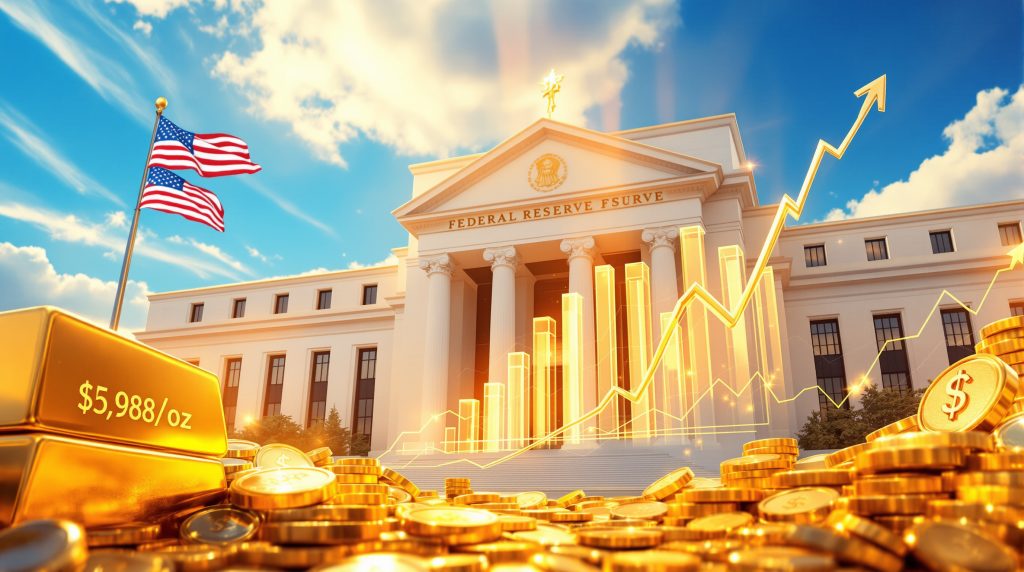Understanding Federal Reserve Rate Cuts and Gold Market Dynamics
The precious metals market operates through complex mechanisms that connect monetary policy decisions with asset valuations. When the Federal Reserve adjusts interest rates, several interconnected forces reshape the investment landscape for gold and other precious metals. Furthermore, the relationship between gold climbs on fed rate cut scenarios demonstrates how monetary accommodation directly influences precious metals valuations.
Lower interest rates fundamentally reduce the opportunity cost of holding non-yielding assets like gold. Unlike bonds or savings accounts that generate regular income, gold produces no dividends or interest payments. When the Fed cuts rates, competing investments offer diminished returns, making gold's lack of yield less of a disadvantage.
This relationship creates a mathematical foundation for gold's appeal during periods of monetary accommodation. Currency dynamics amplify this effect as rate reductions typically weaken the dollar through reduced foreign capital inflows.
Since gold trades in dollars globally, a weaker dollar makes precious metals more affordable for international buyers, expanding demand across global markets. The inflation expectations component adds another layer to this relationship.
Market Forces Behind Gold's Rise to $3,980 Per Ounce
Gold's climb to $3,980 per ounce on October 30, 2025, reflected multiple catalysts converging simultaneously. The Federal Reserve's 25-basis-point rate reduction to a target range of 3.75%-4.00% provided the primary technical driver, but geopolitical developments amplified the metal's momentum.
The timing of President Trump's trade negotiations with Chinese President Xi Jinping created additional uncertainty that benefited safe-haven assets. Consequently, market participants processed both the immediate impact of lower borrowing costs and the potential implications of evolving U.S.-China economic relationships.
Technical factors contributed to the price movement as well. December gold futures initially declined 0.2% to $3,991.50 per ounce, indicating some profit-taking in paper markets while physical spot prices advanced. This divergence often signals strong underlying demand from investors preferring immediate delivery over contract speculation.
The 1.3% single-day gain represented significant movement in precious metals markets, where daily fluctuations typically range between 0.5% and 1.0%. Such pronounced moves usually require multiple fundamental catalysts rather than isolated policy announcements.
Market analysts noted that gold's response exceeded typical rate cut reactions, suggesting investors viewed the Fed's decision within broader economic uncertainty rather than as an isolated monetary policy adjustment. In addition, recent gold prices analysis reveals how multiple factors contribute to these significant price movements.
U.S.-China Trade Relations and Precious Metals Impact
The intersection of international trade policy and precious metals markets became apparent through recent diplomatic developments. President Trump's face-to-face negotiations with President Xi Jinping in Busan, South Korea, produced agreements affecting multiple commodity sectors beyond traditional precious metals.
Key negotiation outcomes included:
• China's commitment to resume U.S. soybean purchases in exchange for tariff reductions
• Delayed implementation of new rare earth export controls
• Continued enforcement of earlier critical mineral restrictions
• Enhanced cooperation on fentanyl trade prevention
The rare earth component carries particular significance for precious metals investors. China's dominance in rare earth production creates supply chain vulnerabilities that often drive investors toward traditional precious metals as portfolio diversification.
When China delays new export restrictions, it reduces immediate supply concerns but maintains longer-term uncertainty about resource access. Agricultural trade agreements, while seemingly unrelated to precious metals, influence broader economic sentiment and currency stability.
Large-scale commodity purchases affect trade balances, which in turn impact dollar strength and precious metals pricing dynamics. Trump's broader Asia trip, encompassing trade breakthroughs with South Korea, Japan, and Southeast Asian nations, demonstrated coordinated efforts to restructure international economic relationships.
Precious Metals Performance Comparison
The October 30, 2025, trading session revealed varying responses across different precious metals, indicating sector-specific demand drivers beyond general monetary policy effects. However, the gold market surge demonstrates how Federal Reserve decisions create ripple effects across the entire precious metals sector.
| Metal | Price Movement | Current Level | Primary Drivers |
|---|---|---|---|
| Gold | +1.3% | $3,980.00/oz | Rate cuts, safe-haven demand |
| Silver | +1.0% | $48.03/oz | Industrial applications, monetary policy |
| Platinum | +1.0% | $1,600.66/oz | Automotive demand, supply constraints |
| Palladium | +2.9% | $1,441.99/oz | Supply deficits, catalytic converter demand |
Palladium's 2.9% gain significantly outpaced other precious metals, suggesting supply-demand imbalances specific to automotive and industrial applications. This metal's primary use in catalytic converters makes it sensitive to vehicle production forecasts and environmental regulations affecting internal combustion engines.
Silver's 1.0% increase reflected its dual nature as both a precious metal and industrial commodity. Electronic manufacturing, solar panel production, and traditional jewellery demand create multiple price support mechanisms that respond differently to economic policy changes.
Platinum's matching 1.0% performance with silver indicates similar industrial demand factors, particularly from automotive applications and chemical processing industries. Nevertheless, platinum's higher price point often limits its appeal as a monetary hedge compared to gold and silver.
The relatively uniform gains across silver and platinum, contrasted with palladium's outperformance, suggest that general monetary policy effects provided baseline support while metal-specific supply factors drove individual variations. For instance, the phenomenon where gold climbs on fed rate cut announcements creates a foundation for broader precious metals appreciation.
Federal Reserve Policy Expectations and Market Positioning
Financial markets demonstrate conflicting interpretations of Federal Reserve intentions despite clear communication from policymakers. Traders currently price in a 70% probability of another rate cut by December 2025, even as Fed Chair Jerome Powell explicitly cautioned against assuming additional accommodation.
Powell's statement that Fed officials "are struggling to reach a consensus about what lies ahead for monetary policy" reveals internal disagreement about appropriate policy direction. This uncertainty creates trading opportunities for investors willing to position against either overly hawkish or dovish expectations.
The disconnect between market pricing and Fed communication suggests several possible interpretations:
• Markets anticipate economic data that would necessitate additional cuts
• Traders believe Fed officials will prioritise employment concerns over inflation risks
• Political pressures may influence monetary policy decisions beyond economic fundamentals
• International economic developments could force Fed accommodation regardless of domestic conditions
This forward guidance complexity creates volatility opportunities across asset classes. When central bank communication lacks clarity or internal consensus, markets often experience increased price swings as participants position for multiple scenarios simultaneously.
The 70% December cut probability embedded in current pricing reflects sophisticated probability weighting rather than simple binary expectations. Professional traders adjust position sizing based on confidence levels rather than making absolute directional bets.
What Drives Central Bank Gold Purchasing Decisions?
Central bank gold boost patterns have emerged as a significant factor supporting precious metals markets. Central banks worldwide continue diversifying reserves away from traditional currency holdings, creating sustained institutional demand that operates independently of retail investor sentiment.
Historical Context and Precedent Analysis
Current gold market conditions share characteristics with previous precious metals bull markets while displaying unique features that distinguish this period from historical precedents. Understanding these similarities and differences provides context for evaluating potential future price trajectories.
The 2008-2011 gold bull market occurred during aggressive Fed accommodation following the financial crisis, with rates near zero and multiple quantitative easing programmes. Gold's advance from approximately $800 to over $1,900 per ounce demonstrated precious metals' response to extreme monetary accommodation combined with financial system uncertainty.
However, current conditions differ significantly from that period. The economy shows greater fundamental strength, employment levels remain relatively stable, and banking system stress appears limited compared to 2008-2009 conditions. These differences suggest that while monetary policy provides support for gold prices, the magnitude of potential gains may differ from previous cycles.
The 2016-2020 period offers another comparison point, characterised by gradual rate normalisation attempts interrupted by trade tensions and eventually pandemic-related accommodation. Gold's performance during this period showed less dramatic gains but demonstrated consistent support during periods of policy uncertainty.
Central bank purchasing behaviour provides additional historical context. Current official sector demand for gold remains elevated compared to historical averages, with central banks adding to reserves as part of currency diversification strategies. This institutional demand creates price floors that may not have existed during previous market cycles.
Emerging Investment Approaches in Response to Policy Changes
Professional investment management has adapted to accommodate precious metals within broader portfolio construction frameworks as traditional asset correlations shift during periods of monetary policy uncertainty. These adaptations reflect sophisticated understanding of gold's role beyond simple inflation hedging.
Portfolio Insurance Strategies have gained prominence among institutional investors seeking downside protection without sacrificing upside participation in equity markets. Allocating 5-15% of portfolio value to precious metals provides insurance against tail risk scenarios while maintaining growth asset exposure.
Currency Hedging Applications utilise gold's negative correlation with the dollar to offset foreign exchange exposures in international portfolios. Rather than using traditional currency forwards or options, some managers employ precious metals positions to achieve similar hedging effects with potentially better long-term performance characteristics.
Tactical Allocation Timing strategies adjust precious metals weightings based on monetary policy cycle positioning and technical analysis indicators. These approaches increase allocations during rate cutting cycles and reduce exposure when policy normalisation appears likely.
Diversification Across Metals recognises that different precious metals respond to varying fundamental drivers. Combining gold exposure with silver, platinum, or palladium positions provides broader commodity sector participation while maintaining precious metals' defensive characteristics.
Risk management considerations have evolved to address precious metals' increased volatility during policy transition periods. Position sizing methodologies now account for higher expected volatility while maintaining target risk levels across overall portfolios.
Potential Headwinds and Risk Factors
Despite supportive factors driving recent precious metals performance, several potential developments could challenge continued upward momentum. Identifying these risks allows investors to maintain appropriate position sizing and risk management protocols.
Economic Data Surprises present the most immediate risk to current positioning. Stronger-than-expected employment reports, consumer spending data, or inflation readings could shift Fed policy expectations and reduce precious metals appeal. The probability-weighted market pricing leaves room for significant repositioning if economic fundamentals exceed current projections.
Dollar Strength Resurgence could emerge from improved U.S. economic performance relative to other major economies or resolution of international trade uncertainties. Since gold trades in dollars globally, sustained dollar appreciation typically creates headwinds for precious metals pricing regardless of domestic monetary policy.
Geopolitical Risk Normalisation may reduce safe-haven demand if current trade negotiations produce comprehensive agreements or other international tensions subside. Gold's current pricing likely includes some premium for ongoing uncertainties that could dissipate with positive diplomatic developments.
Technical Resistance Levels become increasingly relevant as prices reach new highs. Historical resistance zones often attract profit-taking from long-term holders, creating supply pressure that can halt or reverse upward trends regardless of fundamental factors.
Interest Rate Environment Shifts remain the primary policy risk. Any indication that Fed officials have reached consensus favouring policy normalisation could quickly alter market expectations and precious metals demand dynamics.
How Do Rate Changes Affect Future Gold Performance?
Examining the current gold price forecast reveals how monetary policy expectations influence longer-term precious metals trajectories. Furthermore, analysts continue monitoring how gold climbs on fed rate cut patterns may establish new trading ranges.
Strategic Portfolio Positioning for Market Uncertainty
Navigating current market conditions requires balanced approaches that acknowledge both opportunities and risks inherent in precious metals investing during monetary policy transition periods. Effective positioning strategies address multiple scenarios while maintaining flexibility for changing conditions.
Allocation Sizing Principles suggest precious metals positions should align with individual risk tolerance and investment timeframes. Conservative investors might consider 10-20% allocations, while more aggressive portfolios could justify 25-30% in precious metals during periods of elevated uncertainty.
Implementation Timing Considerations favour gradual accumulation over large single purchases, particularly given current volatility levels. Dollar-cost averaging approaches help smooth entry prices while reducing the impact of short-term price fluctuations on overall position performance.
Diversification Methodologies extend beyond simple gold purchases to include silver exposure for industrial demand characteristics and potentially platinum or palladium for sector-specific growth drivers. This multi-metal approach provides broader precious metals participation while reducing single-asset concentration risks.
Risk Management Integration requires clear position sizing limits and predetermined exit strategies for various scenarios. Establishing profit-taking levels and stop-loss parameters before entering positions helps maintain disciplined approaches during emotionally charged market periods.
The current environment demands active monitoring of both monetary policy developments and international trade negotiations, as these factors will likely determine precious metals performance over the coming months. Additionally, understanding record-high gold prices helps establish context for current positioning decisions.
Long-Term Outlook and Structural Considerations
Beyond immediate policy influences, several structural factors may support sustained precious metals demand regardless of short-term monetary policy adjustments. Understanding these longer-term drivers provides context for strategic allocation decisions.
Monetary System Evolution continues as central banks worldwide explore digital currencies and alternative reserve assets. While the timeline remains uncertain, any shifts away from traditional dollar-based reserve systems could enhance gold's role in international monetary arrangements.
Inflation Expectations Management becomes increasingly complex as central banks balance employment objectives against price stability mandates. Historical precedent suggests that when policy makers prioritise employment over inflation control, precious metals often outperform traditional financial assets.
Central Bank Reserve Diversification trends show continued official sector purchases as emerging market economies reduce dollar dependency. This institutional demand provides fundamental price support that may persist independent of Western monetary policy cycles.
Real Interest Rate Environment calculations suggest that even with recent rate increases, real rates (adjusted for inflation) remain near historical lows. Sustained negative or low positive real rates historically correlate with strong precious metals performance over multi-year periods.
According to Morningstar analysis, investor demand for precious metals continues climbing as market participants seek portfolio protection. Meanwhile, CNBC reports highlight how trade negotiations influence precious metals consolidation patterns.
Investment Disclaimer: Precious metals investing involves significant risks, including price volatility and potential losses. Market conditions can change rapidly based on economic developments, policy changes, and international events. Past performance does not guarantee future results. Investors should conduct thorough due diligence and consider consulting financial advisors before making precious metals investment decisions.
The convergence of Federal Reserve monetary accommodation, evolving international trade relationships, and underlying structural economic shifts creates a complex but potentially favourable environment for precious metals investing. Success requires careful attention to both immediate catalysts and longer-term fundamental developments that could shape market conditions over the coming years.
Want to Capitalise on ASX Gold and Mining Discoveries?
Discovery Alert's proprietary Discovery IQ model delivers instant notifications on significant ASX mineral discoveries, including gold opportunities, empowering subscribers to identify actionable trading prospects ahead of broader market awareness. Begin your 30-day free trial at Discovery Alert today and secure your competitive advantage in precious metals and mining investments.




